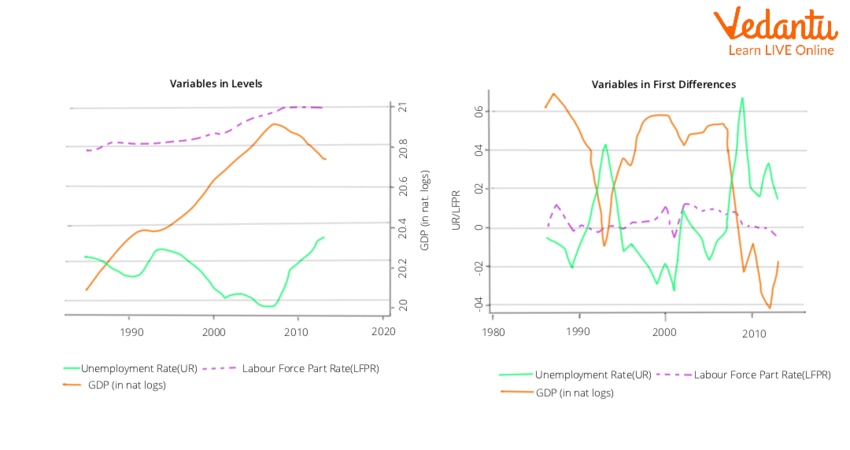




Okun's Law: An Overview
Okun's law, named after economist Arthur Okun, examines the relationship between two important macroeconomic variables, unemployment, and output. According to the statement, "for every 1% reduction in unemployment in an economy, GDP will increase by 2% and GNP will increase by 3%." It implies an inverse relationship between unemployment and GDP and GNP. This statute is well-known for its clarity and precision. Nonetheless, many questions have been raised about this rule, as it is not applicable to every state or economy. To be clear, in an industrialised economy with robust labour markets, the percentage change in GDP has less of an impact on the unemployment rate.
Okun's Law
Okun's law Formula

Okun's Law Formula
Due to the inverse relationship between unemployment and GDP, the output gap—the difference between actual and potential GDP—is equal to the change in unemployment multiplied by the negative Okun coefficient.
The Okun coefficient would always equal 2 according to the conventional version of Okun's law. In today's context, this coefficient may not always be two and may vary depending on the state of the economy.
Okun's Law Meaning and Usefulness
The economic cycle begins with investment. Outside investment benefits any industry in which a corporation is involved. Investment leads to higher production levels, which necessitates more workers, raising the employment rate yet again. As a result, a decrease in the unemployment rate eventually raises the nation's GDP. Product and service sectors, as well as other industries, all contribute to the nation's GDP.
Okun's formula is based on this logic. According to Arthur Okun's Law, for every 1% decrease in unemployment, GDP grows by 2%. However, in today's world, this concept does not apply to all economies. While Okun's law works in the same way—that is, when unemployment rates fall, the nation's GDP rises, and vice versa—the Okun Coefficient varies from country to country depending on economic circumstances.

Okun's Law Economic Growth and Unemployment
Why do GDP and unemployment rates differ?
GDP expands and contracts faster than the unemployment rate for a variety of reasons, including a reduction in the multiplier effect produced by workers' money circulation; people with jobs working fewer hours; a potential decline in labour productivity; companies keeping more employees than they need; and the possibility that unemployed people will stop looking for work and leave the labour force, leaving them out of the unemployment data.
Law of increasing state activities
Adolph Wagner, a German economist, conducted a thorough investigation into the rise in public spending in the late nineteenth century. Based on his research, he created "The Law of Increasing State Activity."
Wagnar's Law states that "the activities and duties of the government increase as the economy improves over time."
"Comprehensive comparisons of different countries and different eras," Adolph Wagner writes, "show that among progressive peoples (societies), with whom we are only concerned, an increase in activity regularly occurs in the activity of both the Central Government and Local Governments, constantly undertaking new functions, while performing both old and new functions more efficiently and completely."
Case Study
When is Okun's law useful? Explain with some examples.
The applicability of Okun's law is a point of contention among economists.
Okun's law has been shown to be accurate across our economy. However, the connection is not always strong.
According to the Federal Reserve Bank of Kansas City, Okun's law "has not always been a tight statistical link." According to the study that produced such findings, economists today frequently believe that the relationship between two variables changes over time.
A more recent investigation by the Federal Reserve Bank of St. Louis, on the other hand, supported Okun's Law. Okun's law "may be a useful guide for monetary policy" if the natural rate of unemployment is accurately calculated, according to the statement.
In order to control inflation, the Federal Reserve, for example, could forecast how rising interest rates will affect the unemployment rate. They can then use that information to forecast the impact of rate hikes on economic growth. This law gives them a more precise and comprehensive picture of how their initiatives will impact the economy.
Conclusion
There is no doubt that Okun's law is one of the simplest and most practical ways to investigate the relationship between economic growth and employment. One of the main advantages of Okun's law is how simply it states that when the economy expands by around 2% faster than expected, unemployment falls by 1%. Given the trends in economic development, relying on it to make precise predictions about unemployment is not a good idea. It has been observed, for example, to change over time and to be influenced by more unusual economic environments, such as jobless recoveries and the 2008 financial crisis. The perfect example of this is the GDP ratio of India. The GDP ratio of India is 3.35 times of GDP at nominal.
FAQs on Okun's Law
1. How does Okun's Law describe the relationship between GDP and GNP?
Okun's law, named after economist Arthur Okun, examines the relationship between two important macroeconomic variables, unemployment and output. It implies an inverse relationship between unemployment and GDP and GNP. Okun's law describes the relationship between employment levels and a country's GDP (or GNP). Okun's law was created by Arthur Okun, a Yale economist who served on President John F. Kennedy's economic advisory council. Okun's law states that a 1% decrease in employment often results in a 2% decrease in GDP. Likewise, a 1% increase in employment equals a 2% increase in GDP.
2. Is Okun's Law Really True?
Although Okun's Law has generally held true throughout history, there have been instances when it has not. In order to assess Okun's Law in 2007, the Federal Reserve Bank of Kansas City compared quarterly changes in unemployment to quarterly growth in real output.
"Okun's law is a simple statistical association, yet it has held up fairly well over time," say experts at the Federal Reserve Bank of San Francisco. In their conclusion, they wrote that the relationship between output and unemployment implied by Okun's rule "remain surprisingly comparable to prior deep recessions."
3. What are the restrictions of Okun's Law?
While Okun's law, which is widely accepted among economists, states that there is a relationship between productivity and employment, economists disagree on the size of that relationship. Furthermore, there are numerous other factors that can influence productivity or employment rates, making it difficult to make precise predictions based solely on Okun's law.
As a result, even economists who believe in the fundamental relationship argue that Okun's law has limited utility as a forecasting tool. According to a Federal Reserve Bank of Cleveland economic analysis, the law's forecasts have "rolling instability," with multiple time periods where the actual change was far greater than what Okun's law would have predicted.









